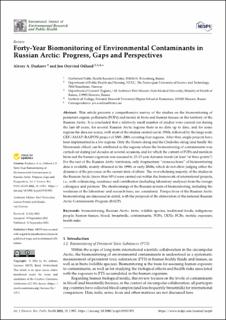| dc.contributor.author | Dudarev, Alexey A. | |
| dc.contributor.author | Odland, Jon Øyvind | |
| dc.date.accessioned | 2023-02-14T08:57:16Z | |
| dc.date.available | 2023-02-14T08:57:16Z | |
| dc.date.created | 2022-10-31T08:39:12Z | |
| dc.date.issued | 2022 | |
| dc.identifier.citation | International Journal of Environmental Research and Public Health (IJERPH). 2022, 19 (19), . | en_US |
| dc.identifier.issn | 1661-7827 | |
| dc.identifier.uri | https://hdl.handle.net/11250/3050596 | |
| dc.description.abstract | This article presents a comprehensive survey of the studies on the biomonitoring of persistent organic pollutants (POPs) and metals in biota and human tissues on the territory of the Russian Arctic. It is concluded that a relatively small number of studies were carried out during the last 40 years; for several Russian Arctic regions there is no data up to date, and for some regions the data are scarce, with most of the studies carried out in 1990s, followed by the large-scale GEF/AMAP/RAIPON project of 2001–2004 covering four regions. After that, single projects have been implemented in a few regions. Only the Nenets okrug and the Chukotka okrug (and hardly the Murmansk oblast) can be attributed as the regions where the biomonitoring of contaminants was carried out during last decades on several occasions, and for which the content of POPs and metals in biota and the human organism was assessed in 12–15-year dynamic trends (at least “at three points”). For the rest of the Russian Arctic territories, only fragmentary “cross-sections” of biomonitoring data is available, mainly obtained in the 1990s or early 2000s, which do not allow judging either the dynamics of the processes or the current state of affairs. The overwhelming majority of the studies in the Russian Arctic (more than 90%) were carried out within the framework of international projects, i.e., with cofinancing, assistance and contribution (including laboratory analyses) from the foreign colleagues and partners. The shortcomings of the Russian system of biomonitoring, including the weakness of the laboratory and research base, are considered. Perspectives of the Russian Arctic biomonitoring are discussed in detail, with the proposal of the elaboration of the national Russian Arctic Contaminants Program (RACP). | en_US |
| dc.language.iso | eng | en_US |
| dc.rights | Navngivelse 4.0 Internasjonal | * |
| dc.rights.uri | http://creativecommons.org/licenses/by/4.0/deed.no | * |
| dc.title | Forty-Year Biomonitoring of Environmental Contaminants in Russian Arctic: Progress, Gaps and Perspectives | en_US |
| dc.title.alternative | Forty-Year Biomonitoring of Environmental Contaminants in Russian Arctic: Progress, Gaps and Perspectives | en_US |
| dc.type | Journal article | en_US |
| dc.type | Peer reviewed | en_US |
| dc.description.version | publishedVersion | en_US |
| dc.source.pagenumber | 0 | en_US |
| dc.source.volume | 19 | en_US |
| dc.source.journal | International Journal of Environmental Research and Public Health (IJERPH) | en_US |
| dc.source.issue | 19 | en_US |
| dc.identifier.doi | 10.3390/ijerph191911951 | |
| dc.identifier.cristin | 2066543 | |
| cristin.ispublished | true | |
| cristin.fulltext | original | |
| cristin.qualitycode | 1 | |

